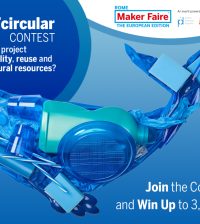- makeITcircular 2024 content launched – Part of Maker Faire Rome 2024Posted 2 weeks ago
- Application For Maker Faire Rome 2024: Deadline June 20thPosted 2 months ago
- Building a 3D Digital Clock with ArduinoPosted 7 months ago
- Creating a controller for Minecraft with realistic body movements using ArduinoPosted 7 months ago
- Snowflake with ArduinoPosted 8 months ago
- Holographic Christmas TreePosted 8 months ago
- Segstick: Build Your Own Self-Balancing Vehicle in Just 2 Days with ArduinoPosted 8 months ago
- ZSWatch: An Open-Source Smartwatch Project Based on the Zephyr Operating SystemPosted 9 months ago
- What is IoT and which devices to usePosted 9 months ago
- Maker Faire Rome Unveils Thrilling “Padel Smash Future” Pavilion for Sports EnthusiastsPosted 10 months ago
Ultrasound to aging wine
It’s a Spanish researchers discovery: shot a river of brandy through a bed of American oak chips and blasted the mix with ultrasound for three days. In this way, they altered a slate of variables, including temperature, an amount of oak chips, alcoholic strength of the liquor, aeration, and more.
The accelerated aging is brought about thanks to ultrasound-induced cavitation in the oak chips, where small bubbles formed by the sound waves “explosively collapse,” blasting the wood’s tissues and releasing compounds that add distinctive flavors to the liquor. Booze experts call these “congeners.”
While the liquor produced by the accelerated aging process can’t legally be called brandy in Europe since regulations require that the spirit be aged in oak casks, Gargía pointed out that the technique could be used to help distillers accelerate their development process.
More adventurous distillers may gin up entirely new alcoholic beverages with unusual flavors. For García, wine is next on the list.
















One Comment